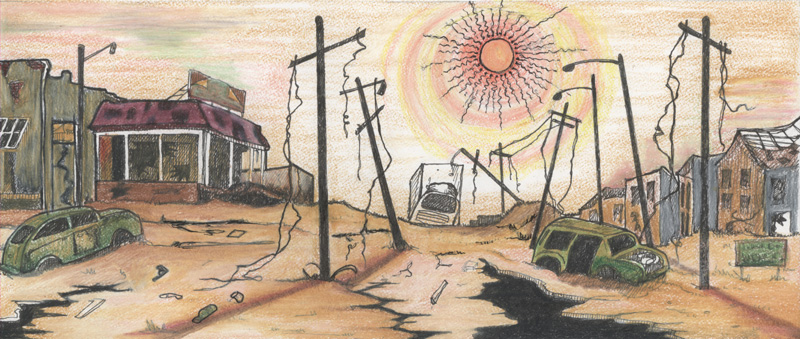
Growth, Inequality, Sustainability & Technology


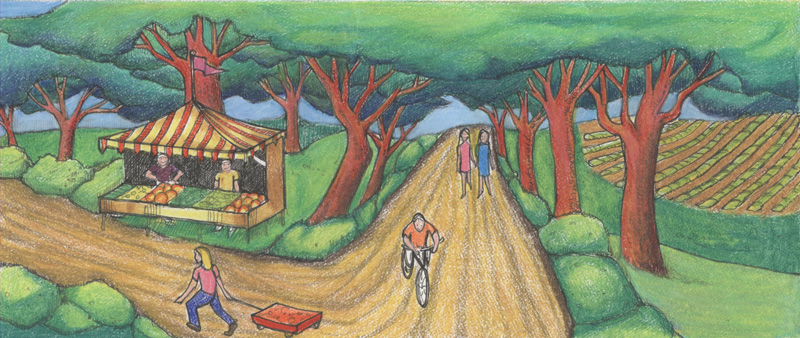
Ritsumeikan University / University of Washington
Oct-Dec 2008
Jelte Harnmeijer
University of Washington
E-mail: jelte@u.washington.edu; Telephone: +1(206)543-9419 (office)
(Artwork by R. Crumb & E. Nicholls)
<version 2008.12.04>
============
_____________
_____________
_____________
Course Overview | The Earth as an Island in Space | "What would you like to learn & do?"
Systems Theory, Thermodynamics and 'Sustainability' | Mass Extinctions | The Collapse of Civilizations | 'The Story of Stuff'
Current Financial Crisis | Technofix Future | 'Ground Noise & Static'
Returns to Scale | Violence | "'Growth Will Kill Us All!' versus 'Growth Will Save Us!'"
Review | Port of Seattle fieldtrip
Demography | In the Beginning | The Dawn of Agriculture | 'Darwin's Nightmare'
Tragedy of the Commons | Intellectual Property
Trade & Industrialization
Inequality
Why are some countries Rich and others poor? | The Last Tree | Democracy and its Discontents
Neocolonialism | Dynamical Systems Theory | The Earth System | Facing the Future | 'Life + Debt'
Week xy: Stuff We Didn't Have Time For
Human Nature | Cultural Contexts
_____________
San Juan Islands
Port of Seattle
Westpoint Sewage Treatment Facility
Olympic Coast
_____________
One World Flag
_____________
_____________
_____________
============
Classes commence Thursday 25 September, terminate Thursday 04 December. Classes are on Tue, Thu 10:30-12:20. Class location: Theodor Jacobsen Observatory, University of Washington Campus.
Each class will start with two student presentations on a 5-10 minute current pertinent global event of choice. Students will be expected to keep up with current events in the media.
A short response paper (minimum 2-3 paragraphs, no maximum) based on the weeks readings, lectures and discussion(s) should be e-mailed to the instructor by Friday 17:00. The purpose of the response paper is to:
(i) test your critical thinking ability;
(ii) test your understanding and knowledge of the weekly material;
(iii) give you the opportunity to explore themes more deeply, if they are of interest to you.
The response paper must meet the following minimum requirements:
(i) ≥1 paragraph on each of the week's lecture topics covered (topics are listed under each week in the syllabus Contents and indicated in Bold in the syllabus itself. Examples: 'Returns to Scale', 'The Dawn of Agriculture', etcetera);
(ii) ≥1 paragraph on each of the weeks readings;
(iii) ≥1 paragraph on the weeks movie, if there was one;
(iv) ≥1 paragraph on the weeks fieldtrip, if there was one;
(v) ≥1 paragraph on the weeks discussions, if any;
(vi) ≥1 paragraph on the week's response question.
These are only the minimum requirements. For extra credit, students are encouraged to:
(i) integrate the above response paper components;
(ii) add alternative perspectives and/or information of their own.
The response paper can be in any commonly used document format (generic .txt, Microsoft .doc, Adobe .pdf, etc.). The subject line in your response paper e-mail should take the following format:
LastName_FirstName_RP##
Where ## refers to the number of the response paper. For example, student Tenzing Dlamini would e-mail his Week 4 response paper with the subject line: "Dlamini_Tenzing_RP04".
1-2 weekly readings will distributed in advance. Optional advanced readings are available.
Active student participation is highly encouraged. Bonus points are available (see Grading).
All class material will be maintained on-line at URL:
http://www.realfuture.org/GIST/course.html
An on-line schedule for project deadlines, relevant seminars and events (compulsory and non-compulsory), etc. is available at URL:
http://www.google.com/calendar/render?hl=en&tab=wc
E-mail me if you require calendar access.
Course Overview
This class aims to link the concepts of Growth, Inequality, Sustainability & Technology ('GIST'). What is Sustainability, and is it even possible? How is sustainability related to Growth, Inequality and Technology?
Our focus will gradually scale in, from the global [Earth] to the local [Community]. In the process, we will examine theoretical and empirical arguments for and against the efficacy and validity of mainstream 'Neoliberal' Economics. Along the way, we will critically examine the role of three important global institutions (the World Bank, International Monetary Fund and World Trade Organization) in the context of GIST. Case studies, using our very own University District as a platform, will highlight aspects relevant to GIST using the two most heavily traded commodities on the planet: oil and coffee.
Overview of Student Responsibilities
Attendance
Bi-weekly presentations
Weekly response papers
Reading
Projects
Fieldtrips
Overview of Grading Methodology
Major course objectives
Foster critical thinking
Build presentation and debating techniques and confidence
The Earth as an Island in Space

The Earth as an island in space
Worst-case scenario
The Biosphere II Project: a possible analogy?
Reading
(None)
Discussion
"What would
 like to learn & do in
this course?"
like to learn & do in
this course?"
you
Excursions
Optional cultural experience: Wall Street bail-out protest
16:00 Thursday September 25; Washington Mutual Building 1301 2nd Ave, downtown Seattle
Depart University Way NE & NE 41st St At 03:33 PM On Route MT 73 Downtown Seattle Express
Arrive University St Sta Ac & Tunnel Sta.-BAY C At 03:53 PM Walk 0.1 mile W to 1301 2ND AVE
Information:
Naomi Klein's website Seattle Activism website
Optional cultural experience: The Battle for Seattle
19:00 Friday September 26; Neptune Theatre, 1303 N.E. 45th at Brooklyn Ave, University District
Systems Theory, Thermodynamics and 'Sustainability'

Introduction to Systems Theory
Closed systems
Fluxes
Matter
Energy
Open systems
Self-organization
Nested hierarchies
Cell < Tissue < Organ < Organism < Community < Ecosystem < Biosphere < Gaia <... < The Universe
Economies
Environmental Economics: The Economy as a sub-system of Gaia
Low-entropy commodities
High-entropy waste products
Physical, theoretical foundation of 'Sustainability'
Entropy, Order and Energy
"Transformation content"
Second Law of Thermodynamics
"In any reaction, the Entropy of the Universe increases"
Entropy/energy flow and Self-organization
Growth, maintenance and decay
Sustainability
Mass Extinctions

Causes
Climate change
The 'Sixth Extinction'
The importance of Timescale
0.1 billion years: sporadic extinctions
1 billion years: loss of oceans
4.5 billion years: loss of Earth
15 billion years: heat death of Universe
The Collapse of Civilizations

Complete and incomplete collapses
Many different models
Resource depletion
War, disease, famine
Roman Empire, Easter Island, Babylonians, Anasazi, Aztecs, Incas, Mayans, Angkor Wat, Pitcairn Island, Henderson Island, Malden Island, ...
Sumer, Mycenaean Greece, Classical Greece, Han Dynasty, Tang Dynasty, Indus Valley, Izapa, Etruscans, Olmec, Ancient Egypt, Norse colony on Greenland, Hittites, Munhumutapa, Ancient Levant, Chin-, Sung- Mongol-, Manchu- China, Cahokia, Tokugawa Shogunate, Hindu-, Moghul- India, ...
The 1929/30 Great Depression
Reading
Movie
The Story of Stuff (Annie Leonard)
Events
What: Gifford Pinochet III, "Happiness, Business & the Environment"
When: Wed 01 Oct 16:00-18:30
Where: HUB106B
Excursions
Optional cultural experience: First Thursday Artwalk
Current Financial Crisis

Recommended reading:
Greider, W. (2008), 'Economic Free Fall: Bailing out the Bad Guys'.
'Plutocracy Reborn', The Nation.
Baker (2008), 'The housing bubble and the financial crisis'.
Sapir (2008), 'Global finance in crisis'.
Sapir (2008), 'How far could the U.S. dollar fall?'.
Debt
United States total public debt
Money owed by the U.S. Federal Government
= 'national debt'; 'U.S. government debt'
Public accounts
Government accounts
'Debt holder'
= 'consumer debt'
Technofix Future
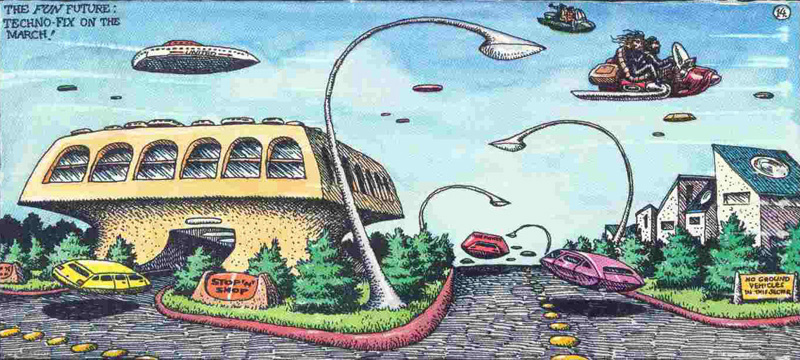
Perspective of Scales
Space
Time
The pace of change
A personal example: Jelte's flamingo story
Technology and Energy
Type I, Type II, Type III -civilizations
Innovation
Synergism
Holism vs. Reductionism
"The whole is more than the sum of its parts"
Example: Delft, Holland in the 1650s [Reinert, pp. 94]
Reading
Movie
'Ground Noise & Static'
Advanced Reading
Returns to Scale
Inputs (factors of production)
I. Land
II. Labor
III. Capital
Types of Capital
1) Natural capital
Renewable
Non-renewable
2) Produced ('manufactured') capital
Buildings; Roads; Factories; ...
Undergoes depreciation and /or replacement
Intangible capital
3) Human capital
Knowledge; Skill
4) Social capital
Institutions; Relationships
IV. Entrepreneurship
Marginal returns
Thomas Malthus (1766 - 1834)
'An Essay on the Principle of Population'
Diminishing marginal returns to scale ("decreasing returns")
Intensive
More labor is added to the same plot of land (or other fixed resource)
Extensive
Production is extended into inferior resources
Increasing marginal returns to scale ("increasing returns")
"Production at a larger scale (more output) can be achieved at a lower cost"
Fixed costs arise when large amounts of capital equipment must be put into place even if only one unit is to be produced.
The costs of this equipment must still be paid even with zero output.
The larger the output, the more the costs of this equipment can be spread out among more units of the good.
Fixed costs
"Those costs that must be incurred even if production were to drop to zero"
Large fixed costs and economies of scale are found in capital intensive industries: chemicals, petroleum, steel, automobiles, other manufacturing, etc.
{Output per unit input} versus {Output} [don't worry about the "1/aLS" stuff!]
In this graph, the y-axis shows the production (= output) per laborer (= input). So, you can also think of the y-axis as showing labor 'efficiency': how much does each average laborer produce?
{Input per unit output} versus {Output} [don't worry about the "aLS" stuff!]
In this graph, the y-axis shows the number of laborers (= input) required per unit production (= output).
This is similar to {Average Cost} versus {Output}. Remember: {Average Cost} = {Total Cost} / {Output}
Violence

Population density
Experiments in rats
Rape
Murder
Homosexuality
Orangutans
Rape
Gorillas
Infanticide
Chimpanzees
Murder
Bonobos
'Pygmy Chimpanzees'
Sex
Dolphins
Bottle-nose dolphin
Adoption of other species
Killing for fun
Humans
Warfare
Co-operation
Technological progress
Example: Second World War radar -> telecommunications -> cellphones, internet, ...
Reading
Meadows, D.H., Meadows, D.L., Randers, J., Behrens, W.W. III (1972), 'The Limits to Growth', Chapter 3: 'Growth in the World System'.
Discussion
"'Growth Will Kill Us All!' versus 'Growth Will Save Us!'"
Week 01-04 Review
Reading
Korten, D., 'When Corporations Rule the World', Chapters 1-2.
Demography

The science of population
Birth rate
Fertility rate
Infant mortality rate
Family size
Death rate
Life expectancy
World map of population growth
World map of population density
In the Beginning

Foraging
Nomadic lifestyle
Small groups (<100)
Low life expectancy (~30 - 40 years)
Low degree of political, economic specialization
Low inequality
Few private possessions
Short lifespans
Zero-sum game
"Your loss is my gain"
More leisure time?
The Dawn of Agriculture

Fertile Crescent
~9000 BCE
Emmer wheat, einkorn wheat, hulled barley, peas, lentils, bitter vetch, chick peas, flax.
Northern China, southern China
~ 6000 BCE
Rice, mung, soy, azuki, taro.
Mesoamerica, Andes
~ 5200 BCE
Maize, manioc, arrowroot, potato, tomato, pepper, squash, several varieties of bean, Canna, tobacco.
New Guinea, Sahel (West Africa)
~ 5000 BCE
Selective breeding
Hybridization
Distribution of suitable species
Example: zebra versus horses
Example: Indian elephants versus African elephants
Disease
Spread
East-West axes
Sedentary lifestyle
Larger group sizes
Division of Labor
Increase in economic and political specialization
Stratification
Land-owners
Low fertility
Non land-owners
Tenants, peasants
High fertility
Hierarchization
Increase in private possessions
Property rights
Land
Increased inequality
Beginnings of Urbanization
European economic, military and political dominance
Why not China?
Fragmentation: coastlines and number/size of political entities
Europe in AD 1100; 1200; 1300; 1400; 1500; 1600; 1700; 1800; 1900; 2000
Competition propels technological innovation
Reading
(continued) Korten, D., 'When Corporations Rule the World', Chapters 1-2.
Movie
'Darwin's Nightmare'
Discussion
(continued) Review
Response Question
"How is International Trade related to the Environment/'Sustainability'?"
Tragedy of the Commons
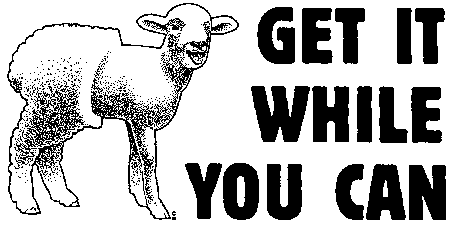
Common Pool Resources (CPR's)
'The Tragedy of the Commons'
'The free-rider problem'
Public goods
Example: Wikipedia
The Harkin Herder Game
'Prisoner's Dilemma'
Non-cooperative
The Central Authority Game
With perfect information
With imperfect information
Transaction costs
Supervision
Enforcement
Intellectual Property

Knowledge
Expandable & self-generating
Transportable & shareable
Non-rival & non-depreciable
Scarcity-value may diminish
Disclosed
Patents
Born in Venice, 1498
‘Litterae patentes’ – open letter
First patent given to John of Utynam, for stained glass
Paris Convention for the Protection of Industrial Property (1883) – still in force
Right to claim priority
International acceptance
Book curse in the monastery of San Pedro, Barcelona:
"For him that stealeth, or borroweth and returneth not, this book from its owner, let it change into a serpent in his hand and rend him. Let him be struck with palsy, and all his members blasted. Let him languish in pain crying out for mercy, & let there be no surcease to his agony till he sing in dissolution. Let bookworms gnaw his entrails ... when at last he goeth to his final punishment, let the flames of Hell consume him forever."
Born in Venice, 1498
Formalized in Britain with Statute of Anne, 1710
Berne Convention for the Protection of Literary and Artistic Works, 1886 – still in force
Victor Hugo
Automatic copyright, no need to register
International recognition of copyrights
U.S. did not sign until 1989
Protection expires
25, 50-100 years after author's death
Applies to creative and intellectual expressions
Books, sound recordings, films, photographs, architectural works, software programs
“right to copy,” or to perform, or to profit, etc.
Trademarks ™ or ®
Brand names
No need for registration
Legal protections
Non-disclosed
Trade secrets
No expiration
Few protections
Contracts of non-disclosure
Subject to leakage & espionage
Example: Coca-Cola
Towards the public domain
Project Gutenberg - http://www.gutenberg.org/wiki/Main_Page
International Music Score Library Project - http://imslp.org/wiki/Main_Page
Creative Commons - http://creativecommons.org/
Free Software Foundation - http://www.fsf.org/
General Public License (GPL)
Free
Must remain open source and available for others to modify and redistribute freely
No monopolies
# Freedom zero is the freedom to run the program as you wish, for any purpose.
# Freedom one is the freedom to study the source code and change it to make it do what you wish.
# Freedom two is the freedom to help your neighbour, that's the freedom to make copies and distribute them to others when you wish.
# Freedom three is the freedom to help your community: the freedom to publish or distribute modified versions when you wish.
WIPO & TRIPS
WIPO
'World Intellectual Property Organization'
UN Agency (1967)
Patents, Copyrights, Trademarks
1 member 1 vote
TRIPS
'Trade Related Aspects of Intellectual Property Rights'
Uruguay Round, World Trade Organization (1994)
North-biased
Reasons for Patents & Copyrights
(1) Promote innovation through guarantees of financial rewards;
(2) Promote public access to information.
"The Congress shall have power . . . to promote the progress of science and useful arts by securing for limited times to authors and inventors the exclusive right to their respective writing and discoveries" - U.S. Constitution, Article 1, Section 8 .
Criteria for patentability
Patentable (cannot patent laws of nature, natural phenomena, or abstract ideas)
Useful (what for?)
Novel (is it new? really new?)
Non-obvious
Adequate description
Reading
Ostrom, E. (1990), 'Governing the Commons', Chapter 1: 'Reflections on the Commons'. pages 1-7 (up to 'The metaphorical use of models').
Reinert, Eric S. (2007), 'How Rich Countries Got Rich ... and Why Poor Countries Stay Poor', Chapter 4: 'Globalization: the Arguments in Favour are also the Arguments Against', pages 112-113.
Advanced Reading
Response Question
"Why are some countries Rich and others poor?"
Trade & Industrialization

History
Integrated global trade is a recent phenomenon
Limited trade between Europe, Africa and Asia for two millennia
The Silk Road
3rd - 17th Centuries
Low volume, high-profit luxury items
Jade, silk, porcelain, fine textiles
Spread of Islam instrumental
Took 18-24 months to complete
Chinese merchant fleet
14th and 15th Centuries
Ended abruptly in 1433
Medieval Europe
Inward looking and conservative
The age of European maritime trade
The importance of Trade
80% by Sea
Value Added
"the additional value of a commodity over the cost of commodities used to produce it from the previous stage of production"
Two approaches
Theoretical Economics
'Free Trade'
Exercise 04: David Ricardo's Theory of Comparative Advantage in International Trade Solutions
Empirical/Historical Economics
| Period | Name of period | Important industries | Inexpensive resource | Infrastructure |
| 1770-1840 | Early mechanization | Textiles Wool |
Water power Cotton |
Canals Roads |
| 1830-1890 | Steam and railway | Iron Transportation |
Steam Coal |
Railroad Steam ships |
| 1880-1940 | Electricity and heavy industry | Electric machinery Chemical industry |
Electricity Steel |
Ships Roads |
| 1930-1990 | Mass production ('Fordism') | Cars Synthetic materials |
Oil | Roads, Planes, Cables |
| 1990-? | Information and communication | Data/Software Biotechnology |
Microelectronics | Digital telecom Satellites |
Low-income countries share of manufactured trade, 1750-1900
Protectionism
"economic policy designed to manipulate trade between nations"
On imports
Import Quotas
Government sets physical limit on amount of a commodity that can be imported
Tariffs on imports
Also "import duty"
Tax on imports
Administrative barriers
e.g. food safety requirements, human rights requirements, environmental requirements, etc.
On exports
Tariffs on exports
Tax on exports
Export bounties
Lowers price of exports
General
Embargoes
Ban on all trade of a particular commodity
e.g. U.S. embargo on Castro's Cuba 1962-
Direct Subsidies
Helps local firms to compete against international competitors
Exchange rate manipulation
European city-states
Wealth created and maintained behind huge barriers
Superior knowledge
Possession of a large variety of manufacturing industry
Created systemic synergies
Market power
Low costs created through innovations and increasing returns
Use of military might
Triple rent system
1) Manufacturing industry
2) Monopoly on at least one raw material
3) Overseas trade
Florence 1200
Prohibited from 'exporting' food from city storage areas
England
King Henry VII, 1485
Wool
Export duties on raw wool
Foreign textile producers have to process more expensive raw material
Later complete embargo under Queen Elizabeth I
Tax exemption for newly established wool manufacturers
Monopoly rights granted to some manufacturers
Later 'Spinning Jenny', 18th Century
Economist John Cary (1649-1720)
'free trade and the death penalty for the export of raw materials'
Venice 1500s
Peace of Westphalia 1648: Emergence of the State
Holland 1500s
Germany
> 1650
Economist Friedrich List
United States
Alexander Hamilton, first US Secretary of the Treasury, 1791
Industrial Revolution > 1820
Japan
Used Friedrich List's toolbox after Meiji restoration
Industrial Revolution >1860
Korea
Used Friedrich List's toolbox
Industrial Revolution >1960
Marshall Plan
US Secretary of State George Marshall
Post-WWII, 1950s and 60s
After failed Morgenthau Plan
Caused serious economic problems in Germany
The Toolbox of Economic Emulation and Development
Exercise 05: Theory of Uneven Development Solutions
| 'Good' Export Activities 'Schumpeterian' activities |
'Bad' Export Activities (if no
Schumpeterian sector present) 'Malthusian' activities |
| Increasing returns | Diminishing returns |
| Dynamic imperfect competition | 'Perfect competition' (commodity competition) |
| Stable prices | Extreme price fluctuations |
| Generally skilled labor | Generally unskilled labor |
| Creates a middle class | Creates 'feudalist' class structure |
| Irreversible wages ('stickiness of wages') | Reversible wages |
| Technical change leads to higher wages for the producer ('Fordist wage regime') | Technical change tends to lower price for the consumer |
| Creates large synergies | Creates few synergies |
Reading
Crichton, M. (2007), 'Patenting Life', New York Times, February 13, 2007.
Ostrom, E. (1990), 'Governing the Commons', Chapter 1: 'Reflections on the Commons', pages 8-15 (from 'Leviathan as the only way' up to but not including 'An alternative solution').
Response Question
"If all countries were equally rich, how would that affect the problems of 'Sustainability'?"
Inequality
.jpg)
Inequality compared to Poverty
Poverty is an absolute term
Inequality is a relative term
Inequality implies the existence of relative wealth and relative poverty
Niveau
Global
Inequality between countries
Examples
Haiti versus U.S.A.
Bangladesh versus Japan
National
Inequality within countries
Examples
Black versus White people in the U.S.A.
Rural versus Urban
Local & Regional
Inequality between members of a community or region
Examples
Lopez Island versus Seattle
South Seattle versus Madrona
Measuring inequality
Patterns of national inequality (within countries)
Patterns of global inequality (between countries)
Warning: But GNP/capita measures averages only!
Important issue in the growth debate
Example: Colonized and Colonizer countries
The case of Brasil
Temporal trends
Evolution of Global Income Distribution for 1970-1999
China, India
World Income and Population distribution in 1990
World Income and Population distribution in 1999
Reading
Buckman, G. (2005), 'Global Trade: Past Mistakes, Future Choices', Chapter 6: 'Trade and the Environment', pages 159-172.
Chang, Ha-Joon (2008), 'Bad Samaritans', Chapter 3: 'My six-year-old son should get a job', pages 65-74 (up to but not including 'The international trading system and its discontents').
Response Question
"Imagine your grandparents when they were your age. Now imagine your parents when they were your age. Now think about yourself. Of the three groups, which experienced the most change? Which was generally the happiest? Discuss, providing detailed reasons."
Why are some countries Rich and others poor?
“For unto every one that hath shall be given, and he shall have abundance: but from him that hath not shall be taken away even that which he hath.”
- Matthew XXV:29, King James Edition
What do people all over the world answer to the question?
1) Evolutionary explanations
“… because some people are clever and others are stupid.”
- Anonymous white South African of Boer ancestry, Hazyview, South Africa, July 2004.
“The idea that some populations are more energetic than others […] perhaps deserves some consideration.”
- J.P. Cole (1979), The Development Gap, page 111.
Map of skin color distribution
No scientific backing
Templeton (1999); Sternberg et al. (2005)
2) Cultural/societal explanations
“Although conventional economic factors have certainly not been ignored, the explanations offered for the contrasting records in growth have most often focused on institutions and highlighted the variation across societies in conditions relevant to growth such as the security of property rights, prevalence of corruption, structures of the financial sector, investment in public infrastructure and social capital, and the inclination to work hard or be entrepreneurial.”
- Sokoloff & Engerman (2000), page 218.
Inadequacy of such explanations.
Can you guess where, in the 19th Century, the following took place:
"Having toured lots of factories in a developing country, an Australian management consultant told the government officials who had invited him: 'My impression as to your cheap labour was soon disillusioned when I saw your people at work. No doubt they are lowly paid, but the return is equally so; to see your men at work made me feel that you are a very satisfied easy-going race who reckon time is no object. When I spoke to some managers they informed me that it was impossible to change the habits of national heritage."
'Tiger economies'
Hong Kong, Singapore, South Korea, Taiwan, (Malaysia).
(3) Environmental explanations
“These areas were settled because the climate was similar to that of Europe.”
- Prof. Wolfram Latsch, personal communication, April 2004.
“I think that tropical diseases are largely to blame.”
- Prof. Roger Buick, North Pole, Australia, August 2004.
'The Resource Curse'
For some countries, having plentiful resources is a bad thing
Jeffrey Sachs & Warner (2005)
(4) Historical explanations
“European countries have been around for a long time. We are young. We just simply need time to catch up.”
- Nxobo Masika, Johannesburg, South Africa, March 2004.
Was the Industrial Revolution built on Inequality?
Colonialism
Cheap raw materials
Access to markets
Example: The Opium Wars
'Anglo-Chinese Wars'
1839-1842 (Treaty of Nanjing) and 1856-1860 (Treaty of Tianjin)
(5) Inept-leadership explanations
“African leaders themselves have also failed the resource-rich continent. They continue to unscrupulously harp on historical injustices to cover up for their political and economic mess that are [sic] a sad manifestation of their suppression of democratic governance. Corrupt and inefficient management of economies, greed, power hunger, disrespect for human rights, cronyism, among other vices, have contributed to the underdevelopment of Africa today.”
- Charles Mangongera, ‘Should We Continue to Blame Colonialism?’, Financial Gazette (Harare, Zimbabwe), September 19, 2002.
“A district our size should have a much better soccer field, but the money was pocketed. There is corruption at all levels. It’s a top-down problem.”
- Unemployed 27-yr-old Sidhinhyo, Morongulos, Mozambique, April 2004.
Evolution of Corruption by Regions of the World, 1984-1999
Who has the most to gain from corruption in poor countries?
(Who has the most to lost from ending it?)
(6) Psychological explanations
“There exists among us a strong feeling of inferiority [… which] comes from our awareness of past [white/European] oppression.”
- Anonymous fisherman, northern Mozambique, April 2004.
(7) Neocolonial explanations
“We were told, and accepted, that our poverty was caused by our poverty in the now famous theory of the ‘vicious circle of poverty’ and we went round in circles seeking ways and means of breaking that circle. Had we asked the [right] questions we would not have exposed our economies to the ruthless plunder brought about by ‘foreign investments’ which the exponents of the vicious circle theory urged us to do. For, it is clear, foreign investment is the cause, and not a solution, to our economic backwardness.”
- Former Tanzanian minister A.M. Babu, In: Walter Rodney (1965), 'How Europe underdeveloped Africa', page 312.
Exploitation (?)
The Last Tree
The Giving Tree (Shel Silverstein)
Discount rate
Discounting the future
The two sides of inequality
Relative wealth
Demand
Relative poverty
Supply
Democracy and its Discontents
Disadvantages
Limited term of office
Appeasing to voters interests and expectations
Short-term planning
Short-term policies
Requires an informed voting population
Motivation to influence voters
Manipulation of education
Manipulation of media
High transaction costs
Requires sophisticated institutional infrastructure
Legal
Laws
Enforcement
Financial
Banking
Information
Education
Media
Potentially cumbersome
Non-reflexive decision making
Reading
Buckman, G. (2005), 'Global Trade: Past Mistakes, Future Choices', Chapter 6: 'Trade and the Environment', pages 172-<end>.
Chang, Ha-Joon (2008), 'Bad Samaritans', Chapter 3: 'My six-year-old son should get a job', pages 74-<end>.
Response Question
"How has your American experience changed who you are? How will you live differently when you return to Japan?"
Neocolonialism
The Birth of Capitalism
Thomas Hobbes (1588-1679):
'Philosophical Rudiments concerning Government and Society' (1651)
'Leviathan' (or ‘the Matter, Forme, and Power of a Commonwealth, Ecclesiasticall and Civil’) (1651)
John Locke (1632-1704):
'Two Treatises of Government' (1689)
David Hume (1711-1776):
'Political Discourses' (1752)
Adam Smith (1723-1790):
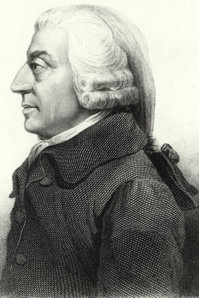
'The Wealth of Nations' (1776)
Classical liberalism
'A doctrine stressing individual freedom and limited government'
Questioned the authority of the feudal society:
Feudalism ![]() Classical liberalism
Classical liberalism
19th & 20th-century political economists
John Maynard Keynes (1883-1946):

'General Theory of Employment Interest and Money' (1936)
Keynesianism: Change government spending to adjust employment, growth, etc.
Milton Friedmann (1912-2006):

'A Monetary and Fiscal Framework for Economic Stability' (1948)
Monetarism: Change money supply to adjust employment, growth, etc.
Neoliberalism
“The doctrine that market exchange is an ethic in itself, capable of acting as a guide for all human action.” (Harvey, 2005)
Strongholds of neoliberal doctrine:
Tenets of Neoliberalism:
The Bretton Woods Conference
Three institutions were envisaged:
(I) International Monetary Fund (IMF)
(II) International Bank for Reconstruction and Development (IBRD)
Became known as the World Bank
(III) International Trade Organization (ITO)
Later came into being as the General Agreement on Trade & Tariffs (GATT) through the 1947 Havana Charter (23 countries)
GATT was transformed to the World Trade Organization (WTO) on 1 January 1995 following the Uruguay Round
U.S. Control
Voting
Voting power not based on one-country, one-vote
Voting power was based on quotas fixed by the U.S.A.
Committees
All committee secretaries and their assistants were American, and had received special training at Atlantic City. They formed a cohesive team to defend the U.S. position.
Objective
“The United States wants, after this war, full utilization of its industries, its factories and its farms; full and steady employment for its citizens, particularly its ex-servicemen; and full prosperity and peace. It can have them only in a world with vigorous trade. But it can have such trade only if currencies are stable, if money keeps its value, and if people can buy and sell with the certainty that the money they receive on the due date will have the value contracted for – hence the [IMF].
With values secured and held stable, it is next desirable to promote world-wide reconstruction, revive normal trade, and made funds available for sound enterprises, all of which will in turn call for American products hence the [World Bank]."
- U.S. Department of State (1948)
'Unholy trinity' of International Institutions
(I) The International Monetary Fund (IMF)
Stated Objectives (IMF Articles of Agreement, Article I) :
(1) To promote international monetary cooperation through a permanent institution which provides the machinery for consultation and collaboration on international monetary problems.
(2) To facilitate the expansion and balanced growth of international trade, and to contribute thereby to high levels of employment and real income and to the development of the productive resources of all members as primary objectives of economic policy.
(3) To promote exchange stability, to maintain orderly exchange arrangements among members, and to avoid competitive exchange depreciation.
(4) To assist in the establishment of a multilateral system of payments in respect of current transactions between members and in the elimination of foreign exchange restrictions which hamper the growth of world trade.
(5) To give confidence to member governments by making the general resources of the Fund temporarily available to them under adequate safeguards, thus providing them with opportunity to correct maladjustment in their balance of payments without resorting to measures destructive of national or international prosperity.
(6) In accordance with the above, to shorten the duration and lessen the degree of disequilibrium in the international balances of payments of members.
Basic facts:
Originally concerned with:
(1) Exchange rates
(2) Balance of payments loans
Structure
Board of Governors
Executive Board
Voting
Most decisions are made by consensus
Voting system weighted by country quota (USA: 17%; Japan and Germany: 6%; France and U.K.: 5%; Saudi Arabia, China and Russia: 3%)
Accomplishments
Khan, M. (1990), ‘The macroeconomic effects of fund-supported structural adjustment programs’, IMF Staff Papers, 37 (2).
Review of 16 studies of how IMF programs affected macroeconomic characteristics:
Balance of Payments [complete national account]:
7 showed positive effects, 4 showed no effects, 3 showed negative effects
Current Account [trade + foreign income+ aid]:
5 showed positive effects, 5 showed no effects, 2 showed negative effects
Inflation [increasing prices]:
2 showed positive effects, 4 showed no effects, 10 showed negative effects
Economic Growth:
4 showed positive effects, 5 showed no effects, 7 showed negative effects
By one account (Budhoo, 1994) 6 million people die each year from the effects of structural adjustment
Overview:
Neocolonialism?
“The importance of ESAF [Enhanced Structural Adjustment Facility] loans stemmed less from the amount of resources provided than from the access which an IMF agreement provided to other official resources.
Without an IMF ESAF agreement, it was impossible to have debt rescheduling through the Paris Club. Moreover, an ESAF programme was often a precondition for grants and loans by bilateral donors, and financing from other international financial institutions in low income countries. ESAF-supported programmes thus shaped policy change in LDC’s, and also acted as the framework for obtaining concessional finance and debt relief in the 1990s.”
- UNCTAD [United Nations Conference on Trade & Development] (2000)
Debt

![]()


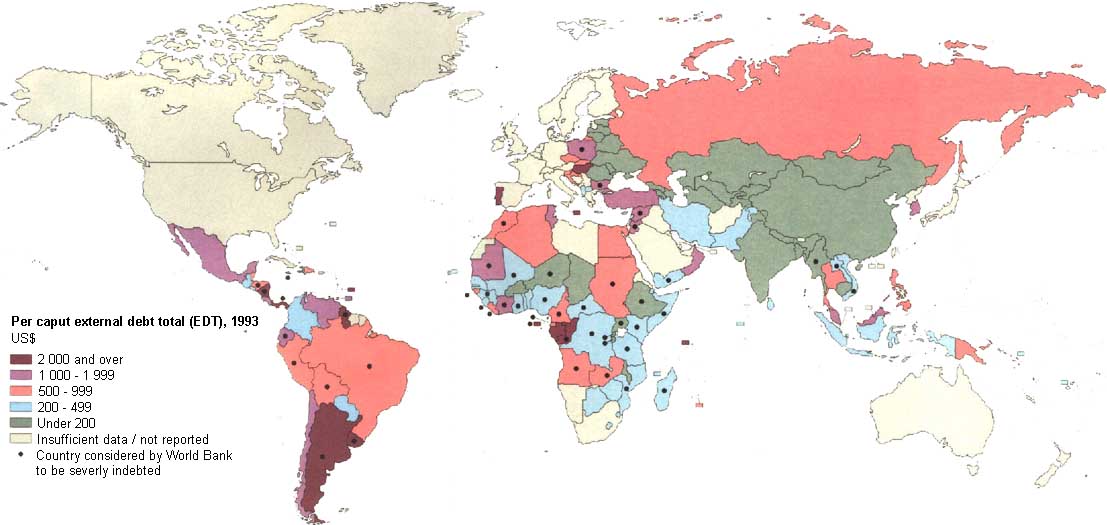
“… a critical examination of [the IMF] suggests that it extracts repayment at the expense of the economy, and especially on the backs of the poor people, of the borrowing country.”
- Richard Peet (2004), 'Unholy Trinity'.
“The IMF likes to go about its business without outsiders asking too many questions. In theory, the fund supports democratic institutions in the nations it assists. In practice, it undermines the democratic process by imposing policies.”
- Former World Bank chief economist Joseph Stiglitz (2003), 'Globalisation and its Discontents'.
(II) The World Bank
International Bank for Reconstruction and Development ('IBRD')
"Our dream is a world without poverty"
- World Bank website
“We never pretended to be good at implementation.”
- Anonymous World Bank development economist, Washington D.C., December 2003.
Overview
Consists of five specialized institutions:
(1) International Bank for Reconstruction and Development (IBRD)
(2) International Development Association (IDA)
(3) International Finance Corporation (IFC)
(4) Multilateral Investment Guarantee Agency (MIGA)
(5) International Centre for Settlement of Investment Disputes (ICSID)
Selected World Bank presidents

Robert McNamara (1916- )
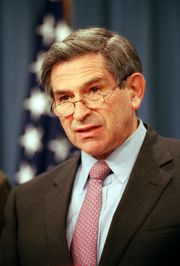
Paul Wolfowitz (1943- )
(III) The World Trade Organization (WTO)
“To help trade flow smoothly, freely, fairly and predictably”
- WTO website
Overview
Rhetoric
“[The WTO] contributes to international peace. Smoothly flowing trade helps people become better off; and more prosperous, contented people are less likely to fight.”
“[The WTO] allows disputes to be handled constructively.”
“A system based on rules rather than power makes life easier for everyone. Decisions in the WTO, made by consensus, with agreements ratified in all members’ parliaments, apply to rich and poor countries alike. The result for smaller countries is increased bargaining power.”
“Freer trade cuts the cost of trading. All people consume. The prices paid for food and clothing are affected by trade policies. Protectionism raises prices. By comparison, the WTO’s global system lowers trade barriers through negotiation and results in reduced costs of production, reduced prices of finished goods and services, and ultimately a lower cost of living.”
“[The WTO] gives consumers more choice. Even the quality of locally produced goods can improve because of competition from imports.”
“Trade raises incomes. Lowering trade barriers allows trade to increase, which adds to national and personal incomes.”
“Trade stimulates economic growth and that means more jobs.”
“The basic trading principles make the system economically more efficient and cut costs. Trade allows a division of labour between countries and lets resources be used more effectively.”
“Trade stimulates economic growth and that means more jobs.”
“The system encourages good government. Under WTO rules, once a commitment has been made to liberalize a sector of trade, it is difficult to reverse. The rules also discourage a range of unwise choices.
Structure
General Agreement on Tariffs and Trade (GATT)
1947 Havana Charter, 23 countries
Goes beyond central government to include measures taken by regional and local governments, including non-governmental bodies exercising powers delegated by government.
The Uruguay Round (1986-94) gave birth to the WTO:
- Modeled on the GATT
- WTO members need to regulate all their services, except those ‘supplied in the exercise of governmental authority’
- Globalizes the protection and enforcement of intellectual property rights
- Prevents requirement of local ownership
- Prevents measures that restrict imports by local enterprises
Restrictions on trade may include:
Neocolonialism?
Globalization
“the compression of the world and the intensification of consciousness of the world as a whole” – Roland Robertson (1992)
“the intensification of world-wide social relations which link distinct localities in such a way that local happenings are shaped by events occurring many miles away” – Anthony Gibbens (1990)
“compression of our spatial and temporal worlds” – David Harvey (1989)
Corporatization
Largest economies on the planet
Adam Smith, in The Wealth of Nations (1776) specifically warned against empowering corporations:
“It is to prevent this reduction of price, and consequently of wages and profit, by restraining that free competition which would most certainly occasion it, that all corporations, and the greater part of corporate law, have been established.”
Corporate control over 'democracy'?
Dynamical Systems Theory
Phase diagrams
Attractors / 'Sinks'
'Sources'
Stability & Perturbations
Lions & Wildebeest
The Earth System
Overview of pertinent issues
Population growth
Pollution
Climate Destabilization
Energy
Water
Food
Technological threats
War & 'Terrorism'
Climate Destabilization
Facing the Future
Acknowledging the Mystery
Humility 謙譲
Gratitude 感謝
Responsibility 義務、責任、任、負担
Dignity 威厳、厳粛、重厚、尊厳、品格
Grace 恩寵、優雅
Movie
Bonus Reading
Pollan, M., 'The Food Issue', New York Times Magazine, October 9th 2008.
Bonus Response Question
"Would you rather live in a world with the U.S.A. or China as the dominant superpower?"
Week xy: Stuff We Didn't Have Time For
Advertising

Economic Growth
“…[it is an] elementary economic axiom … that prosperity has no fixed limits. It is not a finite substance to be diminished by division.”
- U.S. Secretary of the Treasury Henry Morgenthau, Bretton Woods, 1943.
Wealth
Traditional Measures: Gross Production
Gross- and Net- National Production ('GNP', 'NNP')
The Balance of Payments
Alternative Measures
Measure of Economic Welfare ('MEW')
Index of Sustainable Economic Welfare ('ISEW')
Happiness
Gross National Happiness
Bhutan
Social Capital (Robert Putnam)
Effects of inequality
The Birth and Life of Capitalism
Origins of Liberalism
Industrial Revolution
Japan
Neo-liberalism
For & Against Growth
Human Nature
Biological: hardware
Cultural: software
Sapolski
Stress
Historical and Cultural Contexts



East meets West (Exhibit, Yang Liu)
Oriental views
Minimalism: Confucianism (Confucius, Lao-Tze), Buddhism (Suzuki)
Occidental views
Individualism: Judeo-Christianity, John Locke, Stuart Mill, Jean-Jacques Rousseau, United States Constitution, Adam Smith
Environmentalism: John Muir, Alfred North Whitehead, Aldo Leopold, Bill McKibben
Reading
Friedman, Thomas L. (1999), 'The Lexus and the Olive Tree', Farrar, Straus and Giroux.
UNEP Intergovernmental Panel on Climate Change, 'Fourth Assessment Report: Climate Change 2007'.
Pascala, S. & Socolow, R. (2008), 'Stabilization Wedges: Solving the Climate Problem for the Next 50 Years with Current Technologies', Science, 305, pp. 968-972.
Costanza, R. et al. (1997), 'The value of the world’s ecosystem services and natural capital', Nature, 387, pp. 253-260.
Bardhan, Pranab (2008), 'Inequality in India and China: Is Globalization to Blame?', YaleGlobal.
Costanza, R. (1980), 'Embodied Energy and Economic Valuation', Science, Vol. 210, No. 4475 (Dec. 12, 1980), pp. 1219-1224.
'One World Flag'
Objectives: (1) Foster team-work; (2) Provide an outlet for Spirit and Imagination.
Due: 08:30 on Thursday 30 October
Groups: Form groups of 4-5 members. Minimum 2 males and 2 females per group. Members must not be accustomed to working together: join class-mates whom you do not know well. Elect a flag group representative. Representative must e-mail list of group member names to instructor by 17:00 on Friday 03 October.
Instructions: (1) "... create a flag – free from language and well-worn clichés – that embodies the idea of global citizenship. A symbol that triggers pride and cohesion, whether worn on a backpack, displayed on a door, or flown on a flagpole. A symbol for anyone to declare membership in a growing and vital human cooperative." (2) Include a detailed written explanation of your flag (meaning, symbols, etc.). (3) Flags will be unveiled on Halloween evening!
Inspiration: AdBusters Magazine
'Global Flows'
Objectives: Exercise in (1) research and data-mining; and (2) visual representation.
Due: 10:30 on Tue 04 December
Groups:
(I) FOREST
Trees, timber, wood, lumber
(II) HYDROCARBONS
Oil, coal, gas
(III) METALS & ORES
(VI) STRATEGIC MINERALS
(V) FOOD
(VI) WEAPONS
Regions:
OCEANIA
(1) Australia & New Zealand
AMERICAS
(2) Canada
(3) United States of America
(4) Mexico
(5) Venezuela
(6) Brazil
(7) Chile, Argentina & Uruguay
(8) South & Central America [except (4)-(7)]
ASIA
(9) China
(10) India
(11) Middle-East
(12) Indonesia
(13) Southeast Asia & Philippines
(14) Russia & former Soviet nations
(15) Japan
AFRICA
(5) Northern Africa
(6) South, Central, East & West Africa
EUROPE
(8) Western Europe
(14) Eastern Europe
Instructions:
Research the flows (exports & imports) of your particular group's commodities for the year 2006 between the 16/17 regions. Include resources produced and used within a region (e.g. oil extracted in the U.S. and used by U.S. consumers). Think of a way to visualize your data quantitatively. Represent the flows of your commodities between the specified regions onto the World Map provided.
Data-sources:
Use any reliable data-sources. Click here for some recommended data-sources.
Coffee
San Juan Islands
Sat 18 Oct 07:00 - Sun 19 Oct 19:00
Saturday
DRIVE: Depart UW Burke Museum Sat 18 Oct 07:00 Arrive Anacortes Ferry Terminal 08:30
FERRY: Depart Anacortes Ferry Terminal 08:50 Arrive Lopez Island Ferry Dock 09:35
(1) Strawbail housing. Lopez Community Land Trust; 758 North Lopez Rd.
(2) Take it or Leave it (Lopez Recycling Centre)
(3) Organic Farm
(4) Chadwick Hill
(5) The Galley restaurant; 3365 Fisherman Bay Rd., Lopez Island
(6) Overnight at Lopez Island Junior/Middle School; 86 School Rd., Lopez Island
Sunday
(7) Breakfast at Holly B's
FERRY: Depart Lopez Ferry Dock Sun 19 Oct 09:55 Arrive Orcas Ferry Terminal 10:45
(8) Bullock Brothers Homestead Potluck
(9) Discussion: How long would you want to live at the Bullock Brothers Homestead?
FERRY: Depart Orcas Ferry Terminal 16:15 Arrive Anacortes Ferry Terminal 17:05
DRIVE: Depart Anacortes Ferry Terminal 17:15 Arrive UW Burke Museum Sun 19 Oct 19:00
Port of Seattle
Thu 23 Oct 08:30 - 12:20
Depart University Way NE & NE 41st St At 08:46 AM On Route MT 30 Seattle Center Arrive Denny Way & Broad St At 09:06 AM Walk 0.5 mile S to 2711 ALASKAN WAY
Depart Broad St & 2nd Ave At 11:41 AM On Route MT 36 Jefferson Park Arrive 3rd Ave & Pine St At 11:49 AM Walk 0.2 mile NE to
Depart Westlake Sta AcRd & Tunnel Station-BAY A At 12:06 PM On Route MT 73 Jackson Park Express Arrive NE Campus Pkwy & Brooklyn-BAY 1 At 12:17 PM
Westpoint Sewage Treatment Facility
Sat 22 Nov 08:45 - 14:30
Meet at 4th
Ave. & University St. at 08:45 AM
Depart: with Metro# 24 at 09:00 from 4th Ave & University downtown
towards Magnolia.
Arrive: Magnolia Blvd West & W Emerson at 09:30.
Depart: with Metro# 33 at 14:00 from 34th Ave W & W Government Way
towards downtown.
Arrive: Arrive 2nd Ave
& Pike St. at 14:30.
Bring: Rain gear, lunch, notebook.
Olympic Coast
Sat 06 Dec 14:30 - Mon 08 Dec 17:00
Accommodation
320 Ocean Drive, P.O. Box 67
La Push, WA 98350
(360) 374-5267 Toll Free: 1-800-487-1267
Equipment
Candle, Sleeping bag, Sleeping mat if you have one, Plate, Fork, Spoon, Chopsticks, Cup, Raingear, Water bottle, A few snacks, Towel, Musical instrument if you have one.
NOTE: Bring any special ingredients you might need if you want to cook a special dish
Itinerary
Leave: Immediately after goodbye ceremony: Sat 06 Dec ~14:30
Return: Mon 08 Dec 17:00
For a more comprehensive list, consult my on-line bibliography at URL: http://www.realfuture.org/erudition.html
Agriculture
Diamond, J. (1997), 'Guns, Germs and Steel: the Fates of Human Societies'.
Civilizations
Diamond, J. (2004), 'Collapse: How Societies Choose to Fail or Succeed'.
Fernández-Armesto, F., 'Civilizations: Culture, Ambition, and the Transformation of Nature'.
Corporatization
Greider, W. (1992), 'Who Will Tell the People?'.
Korten, D. (2001), 'When Corporations Rule the World'.
Culture
Nisbett, R.E. (2001), 'The Geography of Thought'.
Demographics
Caldwell, J. (2006), 'Demographic Transition Theory'.
Disease
Wolfe N. D., Dunavan C. P., Diamond J. (2007), 'Origins of major human infectious diseases', Nature 447(7142), 279-283.
Environmental Economics
Douthwaite, R. (1999), 'The Growth Illusion'.
Daly, H. & Cobb, John B. (1994), 'For the Common Good'.
Futurism
Kurzweill, R. (2005), 'The Singularity is Near: When Humans Transcend Biology'.
Globalization
Greider, W. (1997), 'One World, Ready or Not'.
Global Inequality
Chang, Ha-Joon (2008), 'Bad Samaritans'.
Reinert, Eric S. (2007) 'How Rich Countries Got Rich ... and Why Poor Countries Stay Poor'.
Growth
Meadows, D.H., Meadows, D.L., Randers, J., Behrens, W.W. III (1972), 'The Limits to Growth', Universe Books, New York.
Happiness
Haidt, J., 'The Happiness Hypothesis'.
Layard, R., 'Happiness'.
Human Nature
Morris, D., 'The Naked Ape'.
Peterson, D., Wrangham, R., 'Demonic Males'.
Russell, B., 'Power'.
de Waal, F., 'Primates and Philosophers'.
de Waal, F., Tyack, P., 'Animal Social Complexity: Intelligence, Culture, and Individualized Societies'.
Institutionalism
Ostrom, E. (1990), 'Governing the Commons'.
Islands
MacArthur, R., Wilson, E., 'Theory of Island Biogeography'.
Japan's Industrial Revolution
Lockwood, W., 'The Economic Development of Japan'.
Neoliberalism
Anderson, T.L., Leal, D.R. (1991), 'Free Market Environmentalism'.
Harvey (2005), 'A Brief History of Neoliberalism'.
Philosophy of Science
Kuhn, T., 'The Structure of Scientific Revolutions'.
Trade
Buckman, G. (2005), 'Global Trade: Past Mistakes, Future Choices'.
Grades will be allocated on the basis of:
(i) Quality of Response papers; [10 x 2% = 20%]
(ii) Quality of Class Projects; [3 x 20% = 60%]
(iii) Current-event Presentation; [1 x 10% = 10%]
(iv) Group discussion Participation. [10 x 1% = 10%]
Bonus points are awarded for:
(i) Extra-curricular material (news articles, websites, books, etc., etc.) brought to the instructor's attention;
(ii) Outstanding engagement in group discussions;
(iii) Voluntary oral presentations (maximum one per person);
(iv) Pointing out any mistakes made by lecturer, including factual and logical errors.
There will be no mid-term or final exam.
Demographics
U.S. Census Bureau International Database
Economics & the Environment
World Resources Institute EarthTrends database
Trade